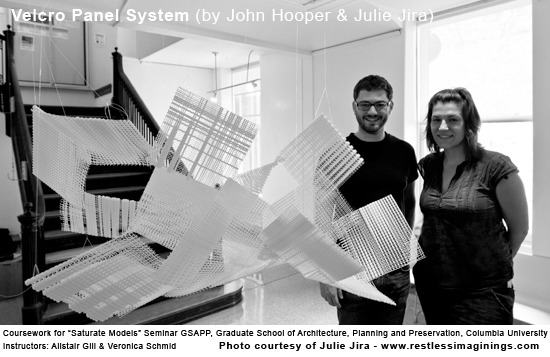Columbia GSAPP Saturated Models 3D printed: Velcro Panel System
Alistair Gill and Veronika Schmid held a Saturated Models seminar at Columbia’s Graduate School of Architecture, Planning and Preservation. During the seminar the Master’s students explored 3D printing and created 3D printed objects. i.materialise made the resulting 3D prints. This is the seventh interview with a team of participating architecture students and their project: Velcro Panel System by John Hooper & Julie Jira.
What is the Velcro Panel System? And does it work like Velcro?
The Velcro Panel System is intended to generate varying degrees of tension within an environment. The tension is facilitated through a hook and loop system, which is conceptually similar to the way Velcro performs. This Velcro panel system works well in tension, especially when hung. The panels are able to adhere to each other and morph into their own set of physical characteristics through interaction with other objects.
Why did you make it?
The intention was to create objects, which would be embedded with the potential for both passive and aggressive levels of engagement within space. It was also intended that collectively, the objects would self-formulate a new set of physical characteristics based on their level of interaction.
At the smallest scale, an environment can interact with the object system through visual, auditory and tactile stimuli. Some panels could be more visual through the gradient change in the openings between the weave. Some could be more acoustically affecting depending on the thickness of the weave and the formulation of spaces between the objects. The tactile aspects of the panels could be characterized by the orientation of the sharp, hook sides, or by the smooth, loop sides of the objects.
Succinctly put, the Velcro panel system could be either experienced as a whole or through the moments of micro interactions generated by the various relationships made between the various types of panels.
What software did you use to make it?
Rhino with Grasshopper
What was the process by which you came to your design?
We looked at microscopic images of Velcro to understand what formulated the relationships of adherence. We then started to physically and digitally test different ways the idea of adhering, or “sticking” could work towards the idea of making space, or making a set of objects situated in space.
Will you be using 3D printing more often in the future?
It would be interesting to continue to explore the idea of malleability versus rigidity through 3D printing with different materials and at different scales. Prototyping connections to see where certain failures or success occur would be a valuable way to utilize 3D printing. How 3D printing is also applicable to the built environment and with the ongoing expansion of printing sizes would also make for an interesting way of engaging with the potentials of 3D printing.
What happened next?
John Hooper is currently in his final year of the Master’s of Architecture program at Columbia University.
Julie Jira recently graduated from the Master”s of Architecture program at Columbia University and is currently working in New York City.
Recommended Articles
No related posts.







